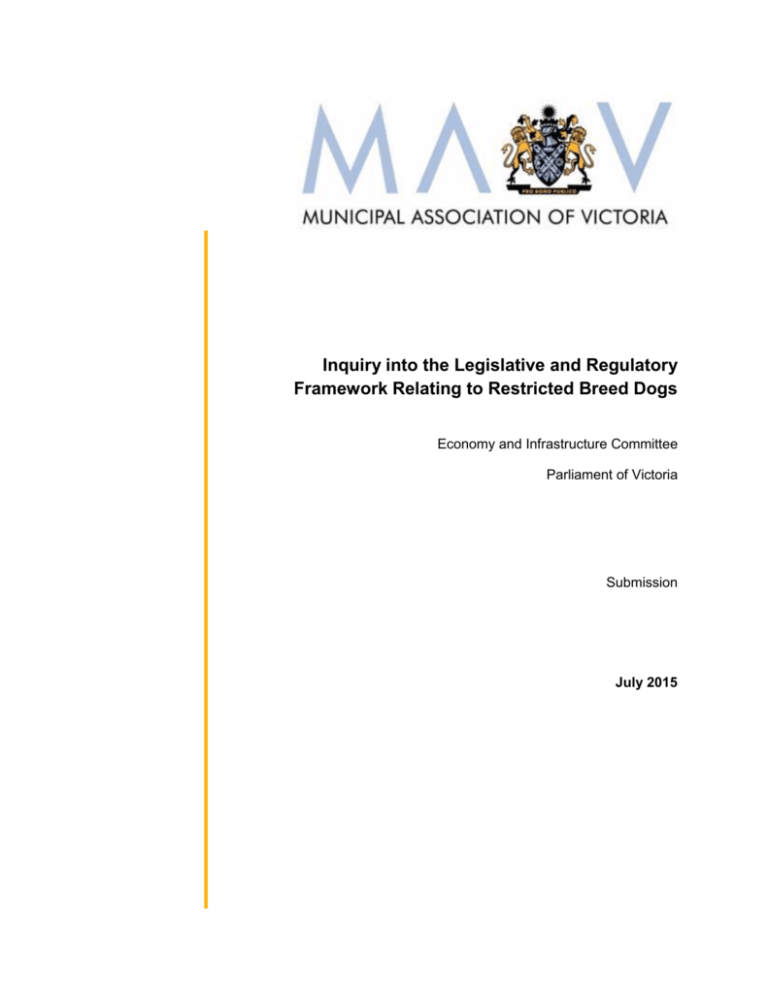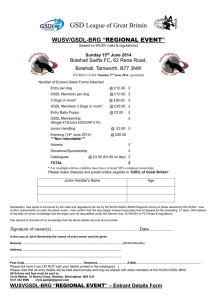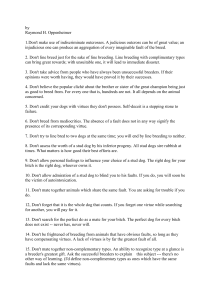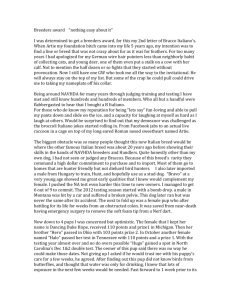Inquiry into the Legislative and Regulatory Framework Relating to
advertisement

Inquiry into the Legislative and Regulatory Framework Relating to Restricted Breed Dogs Economy and Infrastructure Committee Parliament of Victoria Submission July 2015 © Copyright Municipal Association of Victoria, 2015. The Municipal Association of Victoria (MAV) is the owner of the copyright in this publication. No part of this publication may be reproduced, stored or transmitted in any form or by any means without the prior permission in writing from the Municipal Association of Victoria. All requests to reproduce, store or transmit material contained in the publication should be addressed to Claire Dunn on (03) 9667 5533. The MAV does not guarantee the accuracy of this document's contents if retrieved from sources other than its official websites or directly from a MAV employee. Table of contents 1 Introduction ......................................................................................................................... 4 2 Councils are critical stakeholders ........................................................................................ 4 3 The restricted breed dog provisions .................................................................................... 5 4 1.1. Availability of, and weighting given to, “expert” opinion ................................................ 5 1.2. Lack of guidance and training provided to authorised officers ...................................... 6 Alternative approaches ....................................................................................................... 7 1 Introduction The Municipal Association of Victoria (MAV) welcomes the opportunity to provide the Economy and Infrastructure Committee with a submission to help inform its inquiry into the legislative and regulatory framework relating to restricted breed dogs. As the statutory peak body for local government in Victoria, the MAV works to represent and advance the interests of all Victorian councils. It is important to acknowledge at the outset of any discussion regarding restricted breed dogs that the MAV does not purport to have expertise in animal breed identification, animal breed temperament or any such matter. Rather this submission focuses on councils’ experience as the sole authorities charged with implementing and enforcing the restricted breed dog legislative provisions and our preliminary views about any future regime. Due to the short timeframe given to respond to this inquiry, this submission has not benefited from detailed discussion or consultation with our members. We expect that a number of councils will provide feedback to the MAV’s request for input following the Committee’s 10 July deadline. We respectfully request that the MAV be able to provide an amended submission at a later date should we receive input that is not sufficiently dealt with in this submission. We understand that the Committee has written to councils seeking responses to a number of questions including in relation to data and records held by councils, staff training, and the provision of responsible dog ownership programs. Several councils have advised the MAV that they have provided the Committee with the requested information. Consequently this submission does not endeavor to respond to those questions on councils’ behalf. The MAV is willing to appear before the Committee should the Committee want us to do so. 2 Councils are critical stakeholders As the only agencies responsible for implementing and enforcing the restricted breed dog provisions of the Domestic Animals Act 1994, it is essential that councils are consulted and their views taken into account when considering any amendments to these provisions. Neither the MAV nor councils were consulted prior to the changes introduced in 2011. As far as we are aware there was only very limited consultation with three councils prior to the 2015 introduction of the moratorium on the destruction of restricted breed dogs. It is frustrating that successive State Governments have failed to properly engage with councils when deliberating changes that have the potential to significantly affect council operations and council budgets. Indeed this failure to consult with local government contravenes the Victorian State-Local Government Agreement (VSLGA) which commits the State to consulting with councils and to consider any cost and resource impacts on local government when contemplating a legislative or regulatory change that councils will be required to administer or enforce. While councils are committed to promoting responsible dog ownership and community safety, and support the intention behind the restricted breed dog legislative provisions - namely to reduce the risk of dog attacks from pit bull type dogs - they also have an obligation to ratepayers to ensure that the measures taken to meet these objectives are effective and efficient. The restricted breed dog provisions have proven to be neither effective nor efficient, and thus we welcome the State’s review of the legislative and regulatory framework. 3 The restricted breed dog provisions The restricted breed dog legislative provisions introduced unilaterally by the State Government in 2011 have proven extremely costly and difficult for councils to implement. The entire restricted breed dog regulatory framework hinges on a council authorised officer’s assessment of more than 40 physical characteristics of a dog. The officer’s assessment is open to challenge at the Victorian Civil and Administrative Tribunal (VCAT). In just over three years, there have been at least 19 VCAT decisions that have set aside councils’ restricted breed dog declarations, and at least three restricted breed dog cases taken to the Supreme Court. VCAT and Supreme Court decision records make clear some of the key challenges councils face when implementing the restricted breed dog provisions, most notably: 1.1. Availability of, and weighting given to, “expert” opinion The Act provides that if an authorised officer is of the opinion that a dog is a restricted breed dog, he or she must make a declaration to that effect. Once made, a declaration is unable to be revoked or amended but the dog owner is able to seek a review at VCAT. Typically, owners do seek that review. Council is then put in the position of being the respondent in the proceedings before VCAT. A practice has developed at VCAT of permitting expert evidence to be given on the issue of whether the dog is a restricted breed dog. A number of veterinarians and breed experts appear to be readily available to assist dog owners by providing expert testimony that refutes council authorised officers’ assessments of the dog. By contrast, local councils have extensively sought but been unable to retain the services of persons qualified to give expert evidence on this issue. Councils have told the MAV that their requests for assistance from the relevant division of the Department of Economic Development, Jobs, Transport and Resources (previously the Department of Environment and Primary Industries) have been denied. Despite drafting the legislation, developing the breed standard, and having subject matter experts at its disposal, the State has consistently refused to support councils at VCAT. VCAT decisions from late 2012 onwards make clear that VCAT members prefer the evidence of veterinarians and other experts to that of council authorised officers. In Kristy Linehan v Hume City Council (2012), for example, the Senior Member noted: `In the normal course, where there is dispute in opinion between a veterinarian and an authorised officer of the Council, VCAT is likely to give greater weight to the veterinarian’ (para. 34). In response to requests for assistance from the MAV, the State sought to broker an arrangement with Dogs Victoria to provide councils with expert support. This arrangement never materialised however, due to Dogs Victoria’s members’ opposition to the legislation. The Australian Veterinary Association (AVA) has also been a vocal opponent of breed specific legislation and cautioned its members against acting as expert witnesses. The vast majority of VCAT decisions regarding restricted breed dog declarations have been in favour of the dog owners. For councils, the typical outcome is a loss at VCAT, the dog returned to the dog owner, and councils (and therefore ratepayers) left with substantial costs arising from the legal proceedings and the lengthy impoundment of the dog. Furthermore, nothing will have been achieved in terms of protecting the community. It is unacceptable that councils have had to expend hundreds of thousands of dollars implementing and enforcing poorly thought-through legislation introduced unilaterally by the State. It’s the MAV’s view that under the current regime even a model pit bull dog would not be confirmed as a restricted breed dog if there was an “expert” willing to testify on behalf of the dog’s owner. 1.2. Lack of guidance and training provided to authorised officers In order to guide authorised officers’ decision making when assessing a suspected restricted breed dog, the State introduced a breed standard that sets out more than 40 physical characteristics of an American Pit Bull Terrier by way of text description, photographs and diagrams. Despite the importance, length and technical complexity of the standard, the only training provided to councils in 2011 by the State to help them apply the standard was a one day unaccredited training session which focused on breed identification more broadly, as well as how to deal with aggressive dogs. No restricted breed dogs were present or made available at that training for viewing or assessment. We understand that a further one day session, without any restricted breed dogs present, was held in 2012, and a 2.5 hour session in 2014. The breed standard is not a simple and straightforward document to apply. Authorised officers’ lack of detailed understanding of specialised terms used within the standard, such as `pastern’ and `occiput’, has been raised by VCAT members as a concern. Both VCAT and the Supreme Court have also raised concerns about the ambiguity and subjectivity of much of the language used within the standard, with the Supreme Court noting that `the drafting of passages of the type under consideration might be reconsidered by the legislature in order that the Standard might be made easier to understand and apply’ (Applebee v Monash City Council (No 2) 2013, para 67). Similarly, the VCAT Vice President found that `the descriptors in the Standard are replete with adjectives which call for opinions and are intelligible only in the context of comparisons’ (Kalamaras v Cardinia Shire Council 2013, para 14). Following amendments to the standard in late 2013, the Department provided authorised officers with a frequently asked questions (FAQ) guide to assist them to understand how to apply the new standard. In Applebee v Monash City Council the VCAT President described the guide as providing `little or no assistance… as to the correct approach to be adopted when construing the New Standard’ (2014, para 32). He found that the `inconsistent statements contained in the Guide make it clear that the issue of the degree of compliance with each criterion, and each element of a criterion where there are multiple elements in a criterion was not well understood when the Guide was published’ (Applebee v Monash City Council 2014, para 32). Council authorised officers are not breed experts. They do not purport to be breed experts nor should they be required to be breed experts. The restricted breed dog legislative provisions as drafted are not able to be effectively implemented by councils. Given the number of VCAT decisions now available that make clear that breed experts are required to implement the legislation to the satisfaction of VCAT, it is incumbent on the State to either amend or repeal the legislation or reallocate responsibility for implementation of the restricted breed dog provisions to authorities other than councils that do have the requisite knowledge and skills. 4 Alternative approaches The MAV understands that breed specific legislation has been tried in a number of interstate and international jurisdictions with little success. As is the case in Victoria, breed specific legislation applied elsewhere has proven to be technically complex, labour intensive, expensive and difficult to enforce. In terms of alternative approaches to improving community safety outcomes in relation to dogs, we are aware that parties, including the AVA, have in the past advocated for a move away from breed specific legislation to temperament testing and / or mandatory obedience training or socialisation of dogs. While the MAV is not opposed to a move in this direction it is essential that the costs of any testing or training be borne by the dog owner and not by councils and ratepayers. It would also be essential that the providers of any of these services be accredited by the State or by a reputable independent authority. If the State intends to head in this direction, it is critical that councils are engaged and consulted throughout the deliberation and development process. In order to be workable councils have noted that the legislation would, at a minimum, need to clearly define when a temperament test should be conducted; what the test must entail; who is able to administer a test; what constitutes a pass or fail; and the consequences of a failed test. It is important to acknowledge that any and all dogs are capable of attack. Ultimately dog owners need to be held accountable for the actions of their dogs. The community needs to understand and accept that responsibility resides with the individual in control of the dog, and together with state and local government, the community (including ideally the media) needs to help reinforce this message to all dog owners. Owner suitability and responsibility are critical to improving community safety outcomes related to dogs. Dog ownership should be understood as a “responsibility” and not a “right”, with the first test of responsible dog ownership being registration of the dog with the local council. The MAV understands that a substantial number of dogs declared by councils to be restricted breed dogs were unregistered at the time they came to council’s attention. For example, all of the 10 dogs declared to be restricted breed dogs by Brimbank City Council and 11 of the 14 dogs declared by Hume City Council were unregistered at the time of declaration. Recognising the many benefits of desexing dogs, including reduced aggressive and anti-social behaviours, we believe the State should give further consideration to mandating desexing for all dogs. Councils have also called for greater investment in education of current and prospective dog owners; harsher penalties for owners of dogs that have attacked a person or another animal; and mandatory temperament and / or socialization training for all dogs that have attacked a person or animal (with the cost of this testing and training borne by the dog owner). In seeking to discharge their duties, council officers have too often been forced to endure abusive, and often threatening, attention from dog owners and their supporters. Several cases have become the subject of extensive social media campaigns that have led to vitriolic messages been sent to individual council officers and witnesses involved in the case. The MAV has been told of officers receiving death threats and of experiencing substantial stress and anxiety as a result of their involvement in restricted breed dog cases. It is disgraceful that council officers have been subject to such threatening and abusive behaviour for simply undertaking their statutory duties. The State, and the community, should condemn this behaviour in the strongest terms. Finally, beyond the problematic restricted breed dog legislative provisions, the Domestic Animals Act as a whole is a complex and cumbersome piece of legislation to work with. For some time now councils have called on the State to review the Act to ensure that it is aligned with community expectations and is able to be effectively administered by councils. The MAV wishes to take this opportunity to again reiterate that call.



